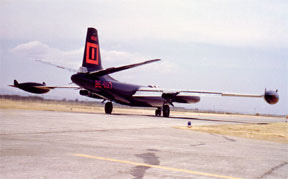 |
Midnight Mission
|
 |
|||||||||
By Howard S. Myers, Jr.
|
|||||||||||
| As I brought the Tornado’s four J47GE-15 jet engines up to full power for takeoff, my mind flashed back to discussions a few days ago. “Would it work?” I asked myself. This mission, in a newly painted all black North American RB-45C (tail #027) jet reconnaissance aircraft would prove or disprove the test flight results and theoretical discussions. We were heading for a target area in the industrial heartland of North Korea, just short of the Yalu River. It was known to be heavily defended by searchlight batteries, and antiaircraft emplacements. We were to bring back sensitive radar and visual photographic reconnaissance data essential for a follow-on B-29 bomber interdiction strike scheduled within 24 hours. |
|||||||||||
| For some reason, I thought searchlights as a part of aerial warfare had become passe after WW II. I was in for a real surprise. After reporting for duty with the 91st Strategic Reconnaissance Detachment in the Far East in 1952, there were a number of briefings on the subject. I was to discover, much to my surprise, that North Korean searchlights presented a very real danger and a high priority threat to our reconnaissance operations. |
|||||||||||
 |
|||||||||||
|
Photo Ctsy. Robert F. Dorr |
|||||||||||
| Searchlights also presented an increasing threat to United Nations fighter and bomber forces operating at medium to low altitudes over North Korea in the winter of 1952. This was principally due to increasingly accurate antiaircraft fire from ground batteries situated around major targets.
The 91st Strategic Reconnaissance Detachment was tasked to provide a highly specialized type of intelligence capability for not only Bomber Command, but major components of Far East Air Forces (FEAF) and over the past few weeks, one theory of countermeasures to our dilemma of searchlight lock-ons sounded feasible. The experts had concluded: “Try painting one of the RB-45s black.” The big unanswered question was: How would it play in the real world, and could we afford to pull an aircraft off the flight line for a couple of weeks while it went through the process of getting painted? We had seen theory and reality clash before. The decision was made to take the gamble. The mission planned for this night would prove the case under actual hostile conditions. A number of test runs were flown in the late winter of 1952 from bases in Japan. If theory proved correct, the results would be applied to future operational tactics over North Korea. The question to be answered was simply: “How effective are searchlights, in fact, against a high flying, non-painted and a completely black painted RB-45C penetrating at high altitudes and high speeds?” Page 1, Page 2, Page 3, Page 4, Page 5, Page 6, Page 7 To Go To — RB-45 Home — or — Miscellaneous RB-45 Home - Contact Us - Cold War Hist. - 91st SRS Hist. - Stardust 40 Mission Story - |
|||||||||||